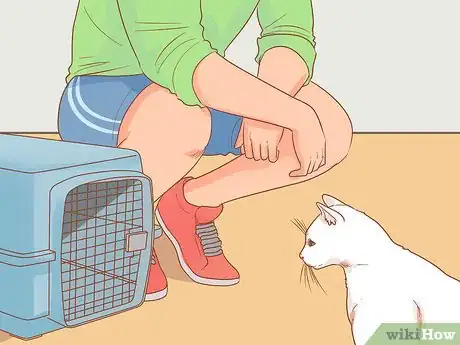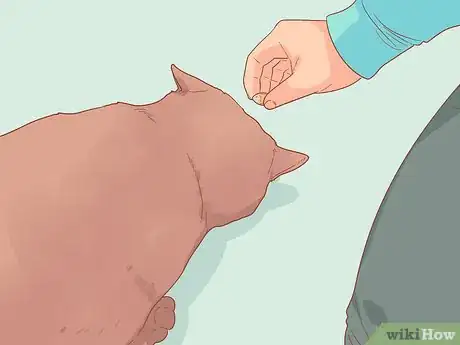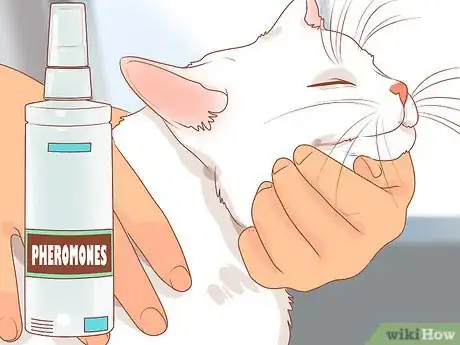This article was co-authored by Lauren Baker, DVM, PhD. Dr. Lauren Baker is a Veterinarian and Assistant Scientist at the University of Wisconsin-Madison. With over 10 years in veterinary medicine, she specializes in the concept of “one health,” which uses insights from veterinary medicine to help human medical research. She holds a Ph.D. in Comparative Biomedical Sciences, a Doctor of Veterinary Medicine, an MS in Comparative Biomedical Sciences, and a Bachelor’s degree in Psychology from the University of Wisconsin-Madison.
This article has been viewed 182,059 times.
New cats take some time to get used to their surroundings and will spend lots of time hiding while they acclimate. Let your cat get comfortable with its new home on its own time, which can take anywhere between two weeks and two months. Help it get used to your presence by sitting near its hiding spot and talking to it. If you need it to come out of hiding at a certain time, like for a vet appointment, try coaxing it with treats, toys, or spraying Feliway to relax it. When you take a new cat home, keep it in one room to encourage it to acclimate faster. Be sure to cat-proof its space to keep it from getting trapped in dangerous hiding spots.
Steps
Building a Trusting Relationship
-
1Give your cat time to get used to its new home. The best way to make your cat comfortable enough to come out of hiding is to give it time to adjust to its new surroundings. Most cats take a couple of weeks to acclimate, but it might take a month or two. During this time, try not to force the cat to come out of its hiding spot.
- Avoid chasing or picking up your cat, especially during this initial timeframe.
- Be patient. If your cat isn’t showing interest when you use these techniques, give it space and try again later.
-
2Sit near its hiding spot and talk to it. While your new cat is adjusting to its new home, you’ll want to get it used to your presence. If it’s hiding, sit near its hiding spot and talk softly to it. This will help get it used to your scent and sounds.[1]
- Try sitting with it in intervals of about 20 minutes a few times a day.
Advertisement -
3Touch its nose with your fingertip. If it comes out of hiding, hold your hand out with a fingertip extended. Let it approach you and smell you on its own. When it does, gently touch your fingertip to its nose to say hello.
- Cats greet each other by touching noses, and you can simulate this by using your fingertip.
-
4Offer your cat treats. Sit calmly near your kitty’s hiding spot and offer it a treat, like a lean piece of chicken or a store-bought treat. If it comes out to take the treat, reward it with another one.
-
5Avoid eye contact and loud noise. Your cat will be a bit stressed out during its acclimation period. When you speak to it, be sure to speak softly, and avoid making lots of noise around it. Try not to make direct eye contact, as your cat will interpret this as a confrontation.
- Reducing your new cat’s stress will help it become comfortable enough to come out of hiding.
Getting Your Cat to Come Out in a Hurry
-
1Give yourself plenty of time to get your cat in a carrier. You’ll likely need a minimum of 20 or 30 minutes to get your cat out of hiding and comfortable enough to get into a carrier. If possible, work this into your schedule so you can avoid having to fight with it and force it into a carrier.
- Try keeping the carrier in its space at all times, and place its food inside the carrier so the cat will associate it with good things.
-
2Offer treats and toys. If you need to make a vet appointment or otherwise get your cat out of hiding in a hurry, try coaxing it with pet treats or a piece of canned tuna. You can also use a chase toy, like a feather on a string, to help it forget about its fear or shyness.
- Continue to play with it for 10 to 15 minutes. If you need to get it in a carrier, try placing treats in the carrier, and avoid forcing it in the carrier unless absolutely necessary.
-
3Try spraying Feliway. Feliway contains synthetic pheromones that can help soothe your cat. Spray it around your cat’s hiding spot to encourage it to come out of hiding. It’ll relax your cat and make it want to investigate the scent.
- Don’t spray Feliway right in front of your cat. It could startle your cat, making it even less willing to come out of hiding.
- Once it’s relaxed, it’ll probably want to rub against you and be stroked. You should give it some loving attention after spraying Feliway instead of trying to rush it into the carrier.
Keeping Your Hiding Cat Safe
-
1Keep your cat in one room when you first bring it home. Your cat will have a harder time acclimating if it’s free to explore your entire home. Instead, keep it in your bedroom or a small, quiet room for at least the first two weeks after bringing it home.
- The room should have a door that closes and should be free of foot traffic. Try to keep your cat away from other people or animals while it gets used to your home.
-
2Make dangerous hiding spots inaccessible. Keeping your cat in one room will reduce the likelihood that it’ll get trapped in dangerous hiding spots, but you should still take the time to cat-proof its room. Make sure HVAC ducts are secure, choose a space that doesn’t have a fireplace, and make sure it can’t knock over any furniture or objects.[2]
- Try to keep your drawers closed, keep it away from appliances like washers or dryers, and keep your closet door closed if you want to keep it off limits.
-
3Let your cat out of its room at night once it becomes acclimated. Once your cat is comfortable with coming out to explore its room, you can start introducing it to the rest of your home. Since cats are nocturnal, start by leaving the door to its room open at night. If it’s back in its room in the morning, close the door to avoid overwhelming it.[3]
- If you can’t find your cat after you’ve let it explore the house, put out a fresh can of cat food or treats and give it some time to come out of hiding. If it has a favorite toy that makes noise, give the toy a shake to get your cat’s attention.
- Be sure to cat-proof before you let your cat explore the rest of your house. Close doors to limit the area that your cat can explore and potentially hide. Keep a secure screen (or, in a pinch, a piece of plywood) over any fireplaces, be sure your washer and dryer doors are closed, and check for loose HVAC ducts.
References
About This Article
To encourage your new cat to come out of hiding, start by sitting near its hiding spot for 20 minutes at a time and speaking to it softly so it gets used to your smell and voice. As you talk to your cat, try holding out a treat, like a piece of chicken. If your cat comes out to take the treat, reward it with another one to reinforce the positive behavior. Then, hold your fingertip out to your cat when it comes out and let it smell you when it’s ready. For tips from our Veterinary co-author on how to get your new cat into its carrier, keep reading!




































































